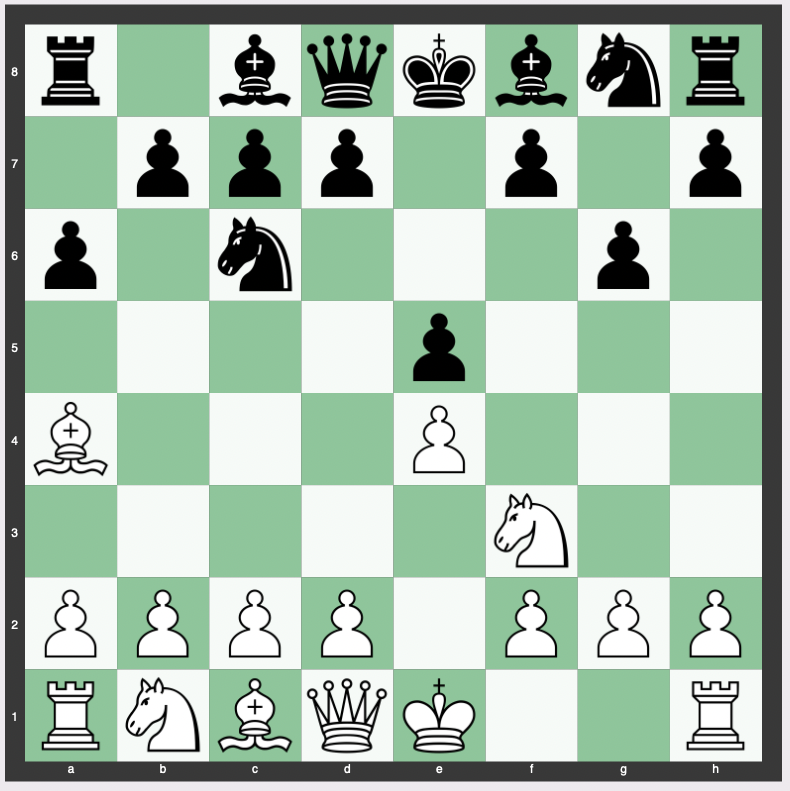The Fianchetto Defense Deferred is part of the Ruy Lopez opening.
The moves in this line are 1. e4 e5 2. Nf3 Nc6 3. Bb5 a6 4. Ba4 g6.
Below we look into the fascinating aspects of this specific defense and its implications on the game.
We will explore its move order, underlying theory, strategy, purpose, variations, history, and its appropriateness for beginners or intermediate players.
Furthermore, we’ll look at its popularity at the grandmaster level.
Move Order of the Fianchetto Defense Deferred
The Fianchetto Defense Deferred in the Ruy Lopez opening involves a specific set of moves.
- e4 e5 – White begins with the King’s Pawn Opening, aiming to control the center, while Black responds in kind, mirroring White’s move.
- Nf3 Nc6 – The knight move attacks Black’s e5 pawn, putting pressure on Black, who in turn develops the knight to defend the e5 pawn.
- Bb5 a6 – This is the start of the Ruy Lopez opening, with White’s bishop pinning the knight to potentially weaken Black’s defense. Black responds with a6, forcing the bishop to decide between capturing the knight or retreating.
- Ba4 g6 – White’s bishop retreats to a4 to maintain the pin and keep pressure on the knight. Black responds with g6, aiming to fianchetto the bishop and fortify their kingside.

Theory, Strategy, and Purpose of the Fianchetto Defense Deferred
The Fianchetto Defense Deferred is essentially a hypermodern strategy, where Black allows White to establish a strong central presence in the early game.
This is done with the idea that this center can later be attacked and undermined.
By playing g6, Black plans to fianchetto the bishop on the long diagonal, aiming to put pressure on the center and increase the defensive strength of the kingside.
The main purpose of this line is to disrupt White’s plans, as the conventional development of pieces in the Ruy Lopez does not usually involve a kingside fianchetto for Black.
The success of this approach highly depends on Black’s ability to coordinate their pieces efficiently and time the counter-attack on White’s center correctly.
Variations of the Fianchetto Defense Deferred
The Fianchetto Defense Deferred can lead to several interesting variations, depending on the moves chosen by both White and Black in subsequent turns.
One possible line could be 4…Nf6, instead of g6, leading to the more traditional Closed Ruy Lopez or the Morphy Defense.
If White chooses to continue with 5. O-O, Black has the option of Bg7, completing the fianchetto, or even d6, providing additional support for the e5 pawn and preparing to develop the dark-squared bishop.
A crucial aspect to remember in these variations is that Black’s plan often relies on counter-attacking and undermining White’s central control, hence, moves should be chosen with this strategic aim in mind.
History of the Fianchetto Defense Deferred
The Ruy Lopez, named after the 16th-century Spanish bishop Ruy López de Segura, is one of the oldest and most classic of all openings.
The Fianchetto Defense Deferred, however, is a much later development and represents a more hypermodern take on the Ruy Lopez.
While it’s difficult to pin down the exact origins of this line, it is a testament to the evolving nature of chess strategy over centuries.
This line remains an example of how even in well-trodden paths like the Ruy Lopez, innovation and creativity can lead to new and complex battlegrounds.
Is the Fianchetto Defense Deferred Good for Beginners or Intermediates?
The Fianchetto Defense Deferred requires a certain level of understanding of chess principles and strategies, particularly those relating to the hypermodern approach.
For beginners, it might be a challenging strategy to execute due to its inherent complexity and need for precise timing of counterattacks.
For intermediate players, however, this could be an interesting addition to their repertoire.
It’s a line that provides the opportunity to disrupt traditional Ruy Lopez players, forcing them into less familiar territory.
Mastering such a line can significantly enhance an intermediate player’s understanding of chess strategy, and especially the delicate balance between center control and counter-attacking chess.
How Often Is the Fianchetto Defense Deferred Played at the Grandmaster Level?
The Fianchetto Defense Deferred in the Ruy Lopez is not a frequently chosen line at the Grandmaster level.
The most common responses to the Ruy Lopez from Black at this level are the Closed Defense (3…a6) followed by 4…Nf6, or the Open Defense (3…Nf6).
The g6 move on the fourth turn is less common due to the potential weakening of the kingside it entails, which can be exploited by highly skilled players.
However, it has been played occasionally as a surprise weapon or when a player wants to avoid the well-analyzed main lines of the Ruy Lopez.
The Fianchetto Defense Deferred is part of the ECO C70 family of variations of the Ruy Lopez.
ECO C70 Ruy Lopez, Fianchetto defense deferred (White perspective)
Conclusion
The Fianchetto Defense Deferred presents an intriguing and less-explored approach to countering the Ruy Lopez.
With its hypermodern principles and the potential to disrupt conventional Ruy Lopez play, it adds a fascinating layer of complexity to the game.
While not the most popular choice at the grandmaster level, or the easiest to master for beginners, it remains a valuable strategic weapon, particularly for intermediate players seeking to deepen their understanding of the game and disrupt their opponents’ comfort zone.
As with all strategies in chess, understanding its history, theory, variations, and implications is key to wielding this defense effectively on the chessboard.


